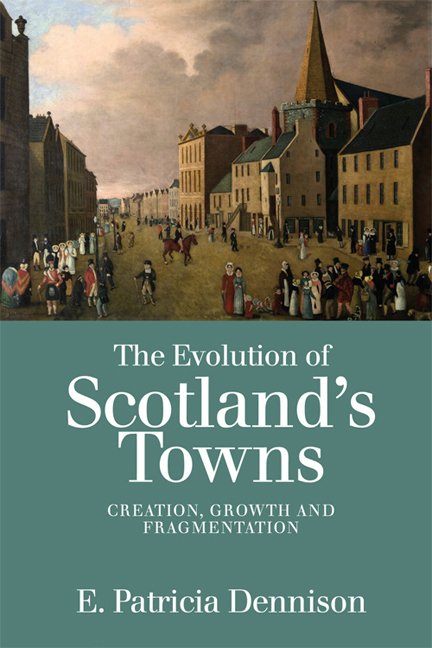Book contents
- Frontmatter
- Contents
- List of Figures
- Acknowledgements
- Image Credits
- List of Abbreviations
- Introduction
- 1 Medieval Towns
- 2 Daily Life in the Middle Ages
- 3 Medieval Faith and the Church
- 4 Encroachment on Burgh Society, 1550–1750
- 5 Man-made and Natural Disasters, 1550–1750
- 6 The Birth of Urban Scotland
- 7 The Victorian Town
- 8 The Twentieth Century
- Post-script: Footprints to Fragmentation
- Appendix: Population Statistics – A Select List
- Bibliography
- Index
1 - Medieval Towns
Published online by Cambridge University Press: 11 November 2020
- Frontmatter
- Contents
- List of Figures
- Acknowledgements
- Image Credits
- List of Abbreviations
- Introduction
- 1 Medieval Towns
- 2 Daily Life in the Middle Ages
- 3 Medieval Faith and the Church
- 4 Encroachment on Burgh Society, 1550–1750
- 5 Man-made and Natural Disasters, 1550–1750
- 6 The Birth of Urban Scotland
- 7 The Victorian Town
- 8 The Twentieth Century
- Post-script: Footprints to Fragmentation
- Appendix: Population Statistics – A Select List
- Bibliography
- Index
Summary
The first documentary evidence of towns comes in the twelfth century. But it is unwise to assume that formal written evidence and the first appearance of towns were coincidental. There is much to suggest that some forms of urban settlement were in existence well before this time. It is known that there were early civilian townships attached to vici, settlements outside the gates of Roman forts, with shops and taverns lining the main road. Here, the merchants and traders who travelled with the army into Scotland set up business. Archaeology has pinpointed Newstead by Melrose (see Fig. 1.1), Inveresk beside Musselburgh and potentially Elginhaugh by Dalkeith; but there is little to suggest that they were truly independent urban settlements. Traprain Law, with its group of agricultural workers and a function as a trading base, would seem to have been some form of proto-urban settlement from the late Iron Age. Typically, the form of settlement that predominated in the eleventh century was the pastoral toun, subsisting on an agricultural basis, growing crops and rearing animals. But there are clues that another form of settlement, which merited the name of urban, existed in this century.
Towns before towns: pre-twelfth-century settlement
Twelfth-century St Andrews had a pre-burghal focal point at Kinrinmund. This was a religious centre which supported the shrine of the saint, and it may be traced back to at least the eighth century and possibly a century earlier. It is unlikely that it could have survived from then without the support of a nearby secular settlement. Indeed, the town's charter of 1144x53 specifically refers to the existing toun; and in 1189x98 the burgesses were given the right to move the existing market cross to their new market place from ‘the place where the clochin used to be’. This was undoubtedly the Gaelic ‘clachan’ (or hamlet) which formed the pre-burghal nucleus of St Andrews. Archaeologists in the town discovered a burgage plot (the piece of land allocated to a freeman of a burgh) overlaying an existing dwelling, and the harbour, being the only safe one between Crail and Ferryport-on-Craig (Tayport), would have been an important venue for pilgrim trade before pre-burghal times.
- Type
- Chapter
- Information
- The Evolution of Scotland's TownsCreation, Growth and Fragmentation, pp. 7 - 46Publisher: Edinburgh University PressPrint publication year: 2017

